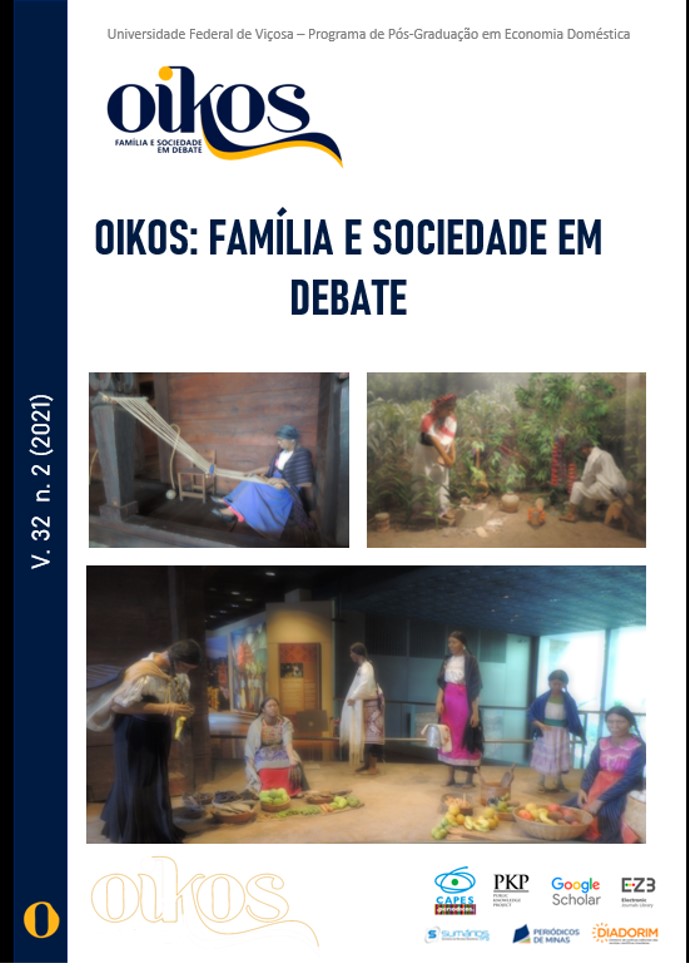THE USE OF SOCIAL NETWORKS FROM A GENDER PERSPECTIVE
DOI:
https://doi.org/10.31423/oikos.v32i2.11233Keywords:
Information and Communication Technologies. Gender Inequalities. Domestic Space.Abstract
This study seeks to understand the uses and purposes that men and women give to Information and Communication Technologies (ICT), as well as their relationship with the social roles played by both in the domestic space. It is assumed that the social roles that men and women play in society, interfere in the uses that both make of technologies and make up gender inequalities. The empirical excerpt took as a reference 325 people, including students, professors and civil servants linked to a Brazilian public university, of both sexes and of different generations. The theoretical approach adopted considers the mutual influence between technology and the social context in which it operates, recognizing the inter-influence between structure and action. The results showed that the uses of ICT for women are more associated with the private space and the practices of family care and, for men, the use of digital media was more focused on opportunities in professional networks. And, even though the new technologies have introduced changes to the way in which care and domestic work practices are coordinated, women still remain the main responsible for them.
Downloads
References
ARAÚJO, Claudimiro Lino de. Idosos e cidadania: um olhar sobre uma construção mediada pelas novas tecnologias de informação e comunicação. Dissertação de Mestrado em Comunicação, Universidade Federal de Goiás. 2017. 127 f.
BAIN, Connie; RICE, Margareth. The Influence of Gender on Attitudes, Perceptions, and Uses of Technology. Journal of Research on Technology in Education, 2014, vol.24, pp. 119-132.
BOLFARINE, Heleno; BUSSAB, Wilton de Oliveira. Elementos de Amostragem. São Paulo: Edgar Blücher. 2005.
BORDAS-BELTRÁN, José-Luis; ARRAS-VOTA, Ana Maria de Guadalupe. “Perspectivas de los estudiantes mexicanos sobre competencias en TIC, definidas por género”. Revista Latina de Comunicación Social, 73, 2018, pp.462-477.
BROSNAN, Mark. Technophobia: The Psychological Impact of Information Technology. Routledge New York, NY. 2003.
CABERO ALMENARA, Julio; LLORENTE CEJUDO, Maria del Carmen. Capacidades tecnológicas de las TICs por los estudiantes. Enseñanza, 24, pp.159-175. 2006.
COUTINHO, Sabrine Mantuan dos Santos; MENANDRO, Paulo Rogério Meira. Representações sociais do ser mulher no contexto familiar: um estudo intergeracional. Psicologia e Saber Social, 2015, 4(1), pp.52-71.
ESCOSTEGUY, Ana Carolina; SIFUENTES, Lirian; BIANCHINI, Aline. Mulheres rurais e seus usos mediados das TICs: tensionamentos e permanências nas relações de gênero. Intercom, Rev. Bras. Ciênc. Comun. [online]. 2017, vol.40, n.1, pp.195-211.
GERSHUNY, Jonathan; GODWIN, Michael.; JONES, Sally. The domestic labour revolution: a process of lagged adaptation? In M. Anderson, F. Bechhofer & J. Gershuny (Eds.), The Social and Political Economy of the Household, Oxford, Oxford University Press, pp. 151-197. 1994.
INSTITUTO BRASILEIRO DE GEOGRAFIA E ESTATÍSTICA – IBGE (2018a). Pesquisa Nacional por Amostra de Domicílios Contínua – PNAD Contínua 2017. Tecnologia da Comunicação e Informação (TIC) - Acesso à Internet e à televisão e posse de telefone móvel celular para uso pessoal, 2017. ISBN 978-85-240-4481-6. Disponível em: <https://servicodados.ibge.gov.br/Download/Download.ashx?http=1&u=biblioteca.ibge.gov.br/visualizacao/livros/liv101631_informativo.pdf> . Acesso em: 14 de março de 2019
INSTITUTO BRASILEIRO DE GEOGRAFIA E ESTATÍSTICA – IBGE (2018b). Estatísticas de Gênero – Indicadores sociais das mulheres no Brasil. Estudos e Pesquisas, Informação Demográfica e Socioeconômica, n.38. Disponível em: <https://biblioteca.ibge.gov.br/visualizacao/livros/liv101551_informativo.pdf>. Acesso em: 20 de junho de 2019
KIMBROUGH, A. M. et al. Gender differences in mediated communication: Women connect more than do men. Computers in Human Behavior, 2013, 29, pp.896–900
KOTZÉ, T. G.; ANDERSON, O.; SUMMERFIELD, K. Technophobia: Gender differences in the adoption of high-technology consumer products. S.Afr.J.Bus.Manage., 2016, 47(1), pp.21-28.
KRASNOVA, A.; et al. “Why men and women continue to use social networking sites: The role of gender differences”. The Journal of Strategic Information System, 2017, Vol. 26, Issue 4, pp.261-284.
KRUG, R. R.; XAVIER, A. J., D’ORSI, E. (2018), “Fatores associados à manutenção do uso da internet, estudo longitudinal EpiFloripa Idoso”. Revista de Saúde Pública, 2018; pp.52-37.
LEITE, Márcia de Paula; GUIMARÃES, Pilar Carvalho. Tudo muda, nada muda: as implicações do uso das tecnologias de informação sobre o trabalho das mulheres no setor eletroeletrônico. Cadernos Pagu, 2015, (44), 2015, p. 333-366.
LEITÃO, Carla Faria; NICOLACI-DA-COSTA, Ana Maria. Impactos da internet sobre pacientes: a visão de psicoterapeutas. Psicologia em estudo. [online]. 2005, vol.10, n.3, pp.441-450.
LING, Rich (2006), Flexible coordination in the Nomos: Stress, emotional maintenance and coordination via the mobile telephone in intact families, in Anandam Kavoori & Noah Arceneaux (eds.), The Cell Phone Reader: Essays in social transformation, NY, Peter Lang, 61-84. 2006.
MUSCANELL, Nicole; GUADAGNO, Rosanna. Make new friends or keep the old: Gender and personality differences in social networking use. Computers in Human Behavior, 2011, 28, pp.107-112.
NDUBISI, Nelson Oly. Effect of gender on customer loyalty: a relationship marketing approach”. Marketing Intelligence and Planning, 2006, 24(1), pp.48-61.
OCDE. (2018), Bridiging the digital gender divide: include, upskill, innovate. Organization for Economic Co-operation and Development
NICOLACI-DA-COSTA, A. M. Ciberespaço: nova realidade, novos perigos, novas formas de defesa. Psicologia: ciência e profissão, Brasília, 2003, v. 23, n. 2, p. 66-75.
PEW RESEARCH CENTER. (2019), Social Media Fact Sheet. June, 2019, Disponível em:< https://www.pewinternet.org/fact-sheet/social-media/>.
SIMÕES, Maria João. Política e Tecnologia. Tecnologias da Informação e da Comunicação e participação política em Portugal, Oeiras, Celta. 2005.
SIMÕES, Maria João; LAS HERAS, Soledad; AUGUSTO, Amelia. Género e tecnologias da informação e da comunicação no espaço doméstico: não chega ter, é preciso saber, querer e poder usar. Configurações, 2011, v. 8. pp: 1-18.
SCHOUTEN, Maria Johanna et al.Tempo e Tecnologia. Uma abordagem de gênero para o contexto português. Covilhã, 2012. (Relatório Técnico).
VAN DIJK, Jan. Afterword: the state of digital divide theory”. In.: M. RAGNEDDA, & G. MUSCHERT (Eds.), Theorizing Digital Divides. New York, London : Routledge, 2018, pp.199-206. Disponível em:<https://ris.utwente.nl/ws/portalfiles/portal/21766828/Jan_van_Dijk_Afterword_Theorizing_the_digital_divide_1_.pdf>. Acesso em: 15 out. 2019.
VAN DIJK, Jan. The Evolution of the Digital Divide. The Digital Divide turns to Inequality of Skills and Usage". In.: Digital Enlightenment Yearbook. J. Bus et al. (Eds.), IOS Press, 2012, pp.57-75.
WAJCMAN, Judy; BITTMAN, Michael; BROWN, Jude. Families without borders: Mobile phones, connectedness and work-home divisions”, Sociology, 2008, 42 (4), pp.635-652.
WALSH, Gianfranco; MITCHELL, Vincent-Wayne. Demographic characteristics of consumers who find it difficult to decide”. Marketing Intelligence & Planning, 2005, 23(3), pp.281-295.
Downloads
Published
How to Cite
Issue
Section
License
Copyright (c) 2021 Oikos: Família e Sociedade em Debate

This work is licensed under a Creative Commons Attribution 4.0 International License.
A revista se reserva o direito de efetuar, nos originais, alterações de ordem normativa, ortográfica e gramatical, com vistas a manter o padrão culto da língua, respeitando, porém, o estilo dos autores.
Os trabalhos publicados passam a ser propriedade da revista Oikos: Família e Sociedade em Debate. Deve ser consignada a fonte de publicação original. Para a disponibilização e utilização dos artigos em acesso aberto, o periódico adota a licença Creative Commons Attribution 4.0 International Public License: CC BY 4.0. Isso significa que outras pessoas podem compartilhar - copiar ou distribuir o material em qualquer mídia ou formato; adaptar - remixar, transformar e criar a partir do material para qualquer fim, desde que atribuído o devido crédito, fornecer um link para a licença e indicar se foram feitas alterações" (CC BY 4.0).
As opiniões emitidas pelos autores dos artigos são de sua exclusiva responsabilidade.
Quanto às questões de plágio, a Oikos utiliza o software de verificação de similaridade de conteúdo – política de plágio (CopySpider) nos artigos submetidos ao periódico.
Ao submeter o artigo, o autor se compromete que os dados relatados no artigo não são resultados de má conduta ética, tais como: dados produzidos, uso indevido de imagens, falsificação, plágio, autoplágio ou duplicidade. O autor declara que nada no artigo infringe qualquer direito autoral ou de propriedade intelectual de outrem, pois, caso contrário, ele poderá responder integralmente por qualquer dano causado a terceiros, em todas as esferas administrativas e jurídicas cabíveis, nos estritos termos da Lei nº 9.610/98



